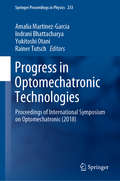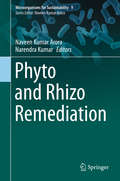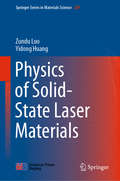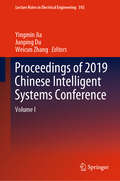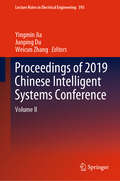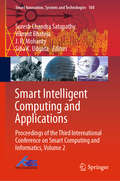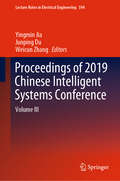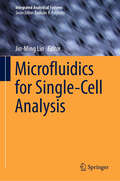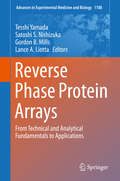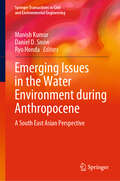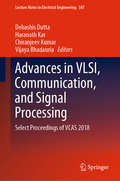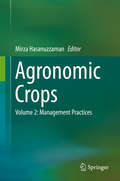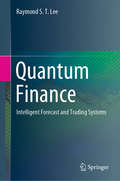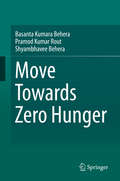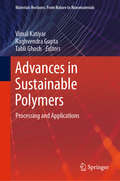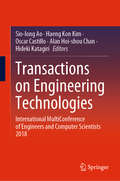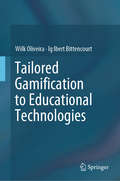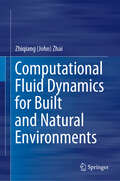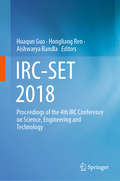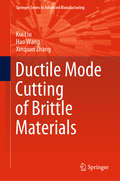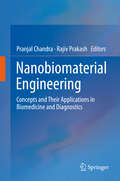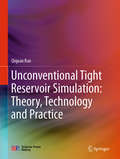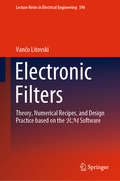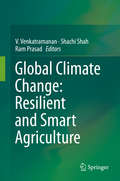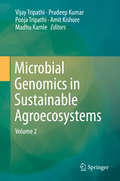- Table View
- List View
Progress in Optomechatronic Technologies: Proceedings of International Symposium on Optomechatronic (2018) (Springer Proceedings in Physics #233)
by Amalia Martínez-García Indrani Bhattacharya Yukitoshi Otani Rainer TutschThis book gathers high-quality papers presented at the International Symposium on Optomechatronic Technology (ISOT 2018), which was organized by the International Society for Optomechatronics (ISOM) and Centro de Investigaciones en Óptica (CIO) in Cancun, Mexico on November 5–8, 2018. The respective papers address the evolution of optomechatronic devices and systems, and their implementation in problem-solving and various other applications. Moreover, they cover a broad range of topics at the interface of optical, mechanical and electrical technologies and methods.
Phyto and Rhizo Remediation (Microorganisms for Sustainability #9)
by Naveen Kumar Arora Narendra KumarThe increasing human population and the associated activities have negatively influenced the ecosystems and life on earth. The continuous addition of agrochemicals, heavy metals and industrial wastes/ effluents in the ecosystems have caused great harm, including loss of productivity, biodiversity, climate change and diseases in plants, animals and humans, resulting in increased marginal lands and endangered sustainability of life on earth. Hence, there is an urgent need to reverse the impact of dangerous pollutants through a holistic, sustainable and biotic approach. Bioremediation involves the utilization of biological systems, mainly plants (phytoremediation) or microorganisms or both in combination (rhizoremediation) for the removal or degradation of pollutants and revive the habitats in an eco-friendly manner. Recently, there have been many success stories related to bioremediation involving plants or plant-microbe interactions. These success stories are related to the removal of heavy metals, pesticides, polyaromatic hydrocarbons, explosives, radionuclides or reduction of biological oxygen demand, total dissolved solids, total suspended solids, oil spills in water bodies. Rhizoremediation has also been successfully used for reclamation of saline or marginal soils. With the range of pollutants and the total area (on earth) covered by these toxic chemicals, it is important that these eco-friendly technologies be utilized in a better way. The book throws light on the recent happenings, research and success stories related to bioremediation of polluted habitats through phytoremediation or rhizoremediation. The book also highlights some of the significantly important plant and microbial species involved in remediation, the physiology, biochemistry and the mechanisms of remediation by various plants and microbes, and suggestions for future improvement of bioremediation technology.
Physics of Solid-State Laser Materials (Springer Series in Materials Science #289)
by Zundu Luo Yidong HuangThis book discusses the spectral properties of solid-state laser materials, including emission and absorption of light, the law of radiative and nonradiative transitions, the selection rule for optical transitions, and different calculation methods of the spectral parameters. The book includes a systematic presentation of the authors' own research works in this field, specifically addressing the stimulated nonradiative transition theory and the apparent crystal field model. This volume is helpful resource for researchers and graduate students in the fields of solid spectroscopy and solid-state laser material physics, while also serving as a valuable reference guide for instructors and advanced students of physics.
Proceedings of 2019 Chinese Intelligent Systems Conference: Volume I (Lecture Notes in Electrical Engineering #592)
by Yingmin Jia Junping Du Weicun ZhangThis book showcases new theoretical findings and techniques in the field of intelligent systems and control. It presents in-depth studies on a number of major topics, including: Multi-Agent Systems, Complex Networks, Intelligent Robots, Complex System Theory and Swarm Behavior, Event-Triggered Control and Data-Driven Control, Robust and Adaptive Control, Big Data and Brain Science, Process Control, Intelligent Sensor and Detection Technology, Deep learning and Learning Control, Guidance, Navigation and Control of Aerial Vehicles, and so on. Given its scope, the book will benefit all researchers, engineers, and graduate students who want to learn about cutting-edge advances in intelligent systems, intelligent control, and artificial intelligence.
Proceedings of 2019 Chinese Intelligent Systems Conference: Volume II (Lecture Notes in Electrical Engineering #593)
by Yingmin Jia Junping Du Weicun ZhangThis book showcases new theoretical findings and techniques in the field of intelligent systems and control. It presents in-depth studies on a number of major topics, including: Multi-Agent Systems, Complex Networks, Intelligent Robots, Complex System Theory and Swarm Behavior, Event-Triggered Control and Data-Driven Control, Robust and Adaptive Control, Big Data and Brain Science, Process Control, Intelligent Sensor and Detection Technology, Deep learning and Learning Control, Guidance, Navigation and Control of Aerial Vehicles, and so on. Given its scope, the book will benefit all researchers, engineers, and graduate students who want to learn about cutting-edge advances in intelligent systems, intelligent control, and artificial intelligence.
Smart Intelligent Computing and Applications: Proceedings of the Third International Conference on Smart Computing and Informatics, Volume 2 (Smart Innovation, Systems and Technologies #160)
by J. R. Mohanty Suresh Chandra Satapathy Vikrant Bhateja Siba K. UdgataThis book presents high-quality papers from the Third International Conference on Smart Computing and Informatics (SCI 2018−19), organized by the School of Computer Engineering and School of Computer Application, Kalinga Institute of Industrial Technology Deemed to be University, Bhubaneswar, from 21 to 22 December 2018. It includes advanced and multi-disciplinary research on the design of smart computing and informatics, focusing on innovation paradigms in system knowledge, intelligence and sustainability that have the potential to provide realistic solutions to various problems in society, the environment and industry. The papers featured provide a valuable contribution to the deployment of emerging computational and knowledge transfer approaches, optimizing solutions in varied disciplines of science, technology and health care.
Proceedings of 2019 Chinese Intelligent Systems Conference: Volume III (Lecture Notes in Electrical Engineering #594)
by Yingmin Jia Junping Du Weicun ZhangThis book showcases new theoretical findings and techniques in the field of intelligent systems and control. It presents in-depth studies on a number of major topics, including: Multi-Agent Systems, Complex Networks, Intelligent Robots, Complex System Theory and Swarm Behavior, Event-Triggered Control and Data-Driven Control, Robust and Adaptive Control, Big Data and Brain Science, Process Control, Intelligent Sensor and Detection Technology, Deep learning and Learning Control, Guidance, Navigation and Control of Aerial Vehicles, and so on. Given its scope, the book will benefit all researchers, engineers, and graduate students who want to learn about cutting-edge advances in intelligent systems, intelligent control, and artificial intelligence.
Microfluidics for Single-Cell Analysis (Integrated Analytical Systems)
by Jin-Ming LinThis book summarizes the various microfluidic-based approaches for single-cell capture, isolation, manipulation, culture and observation, lysis, and analysis. Single-cell analysis reveals the heterogeneities in morphology, functions, composition, and genetic performance of seemingly identical cells, and advances in single-cell analysis can overcome the difficulties arising due to cell heterogeneity in the diagnostics for a targeted model of disease. This book provides a detailed review of the state-of-the-art techniques presenting the pros and cons of each of these methods. It also offers lessons learned and tips from front-line investigators to help researchers overcome bottlenecks in their own studies. Highlighting a number of techniques, such as microfluidic droplet techniques, combined microfluidics-mass-spectrometry systems, and nanochannel sampling, it describes in detail a new microfluidic chip-based live single-cell extractor (LSCE) developed in the editor’s laboratory, which opens up new avenues to use open microfluidics in single-cell extraction, single-cell mass spectrometric analysis, single-cell adhesion analysis and subcellular operations. Serving as both an elementary introduction and advanced guidebook, this book interests and inspires scholars and students who are currently studying or wish to study microfluidics-based cell analysis methods.
Reverse Phase Protein Arrays: From Technical and Analytical Fundamentals to Applications (Advances in Experimental Medicine and Biology #1188)
by Tesshi Yamada Satoshi S. Nishizuka Gordon B. Mills Lance A. LiottaThis book provides practical guidance on all aspects of reverse phase protein array (RPPA) technology, which permits the quantification of protein levels in cell or tissue lysates. In addition, the latest results are presented from laboratories across the world where experts are successfully running the challenging RPPA data platform. After an introductory chapter by the inventor of the RPPA technique, the demanding task of lysate preparation is explained. Subsequent chapters review printing platforms and analytical platforms and discuss antibody screening in detail. The role of RPPA data in integrative analyses is thoroughly examined, and the various applications of RPPA, for example to identify molecular targeting drugs or evaluate cancer drug efficacy, are discussed with reference to the latest knowledge. It is hoped that the book will foster the implementation of RPPA by documenting the practical details of the technology and by revealing its great potential. It will be of high value for researchers who plan to build an RPPA platform in their institute and for researchers, clinicians, and companies who use RPPA through collaboration with an existing RPPA facility.
Emerging Issues in the Water Environment during Anthropocene: A South East Asian Perspective (Springer Transactions in Civil and Environmental Engineering)
by Manish Kumar Daniel D. Snow Ryo HondaThis book intends to bring together and integrate the subject matter of water quality. The book covers aspects of water related to climate change, emerging aspects of engineering sciences, bio-geochemical sciences, hydro geochemistry, river management and morphology, social sciences, and public policy. The book covers the role of disruptive innovations in water management, policy formation and impact mitigation strategies. The book includes lab results as well as case studies. It provides recommendations and solutions for policy making and sustainable water management. The chapters in this book deal cohesively with many aspects of the water environment during the Anthropocene era. The contents cover myriad issues, such as land degradation, water scarcity, urbanization, climate change, and disruptive innovation. The book also discusses issues highly pertinent to society and sustainability, such as the prevalence of enteric viruses and pharmaceutical residues as a possible anthropogenic markers in the aquatic environment. The book will prove useful for students, professionals, and researchers working on various aspects of water related concerns.
Advances in VLSI, Communication, and Signal Processing: Select Proceedings of VCAS 2018 (Lecture Notes in Electrical Engineering #587)
by Debashis Dutta Haranath Kar Chiranjeev Kumar Vijaya BhadauriaThis book comprises select proceedings of the International Conference on VLSI, Communication and Signal processing (VCAS 2018). It looks at latest research findings in VLSI design and applications. The book covers a wide range of topics in electronics and communication engineering, especially in the area of microelectronics and VLSI design, communication systems and networks, and image and signal processing. The contents of this book will be useful to researchers and professionals alike.
Agronomic Crops: Volume 2: Management Practices
by Mirza HasanuzzamanAgronomic crops have provided food, beverages, fodder, fuel, medicine and industrial raw materials since the beginning of human civilization. More recently, agronomic crops have been cultivated using scientific rather than traditional methods. However, in the current era of climate change, agronomic crops are suffering from different environmental stresses that result in substantial yield loss. To meet the food demands of the ever-increasing global population, new technologies and management practices are being adopted to boost yields and maintain productivity under both normal and adverse conditions. Further, in the context of sustainable agronomic crop production, scientists are adopting new approaches, such as varietal development, soil management, nutrient and water management, and pest management. Researchers have also made remarkable advances in developing stress tolerance in crops. However, the search for appropriate solutions for optimal production to meet the increasing food demand is still ongoing. Although there are several publications on the recent advances in these areas, there are few comprehensive resources available covering all of the recent topics. This timely book examines all aspects of production technologies, management practices and stress tolerance of agronomic crops.
Quantum Finance: Intelligent Forecast and Trading Systems
by Raymond S. LeeWith the exponential growth of program trading in the global financial industry, quantum finance and its underlying technologies have become one of the hottest topics in the fintech community. Numerous financial institutions and fund houses around the world require computer professionals with a basic understanding of quantum finance to develop intelligent financial systems. This book presents a selection of the author’s past 15 years’ R&D work and practical implementation of the Quantum Finance Forecast System – which integrates quantum field theory and related AI technologies to design and develop intelligent global financial forecast and quantum trading systems. The book consists of two parts: Part I discusses the basic concepts and theories of quantum finance and related AI technologies, including quantum field theory, quantum price fields, quantum price level modelling and quantum entanglement to predict major financial events. Part II then examines the current, ongoing R&D projects on the application of quantum finance technologies in intelligent real-time financial prediction and quantum trading systems. This book is both a textbook for undergraduate & masters level quantum finance, AI and fintech courses and a valuable resource for researchers and data scientists working in the field of quantum finance and intelligent financial systems. It is also of interest to professional traders/ quants & independent investors who would like to grasp the basic concepts and theory of quantum finance, and more importantly how to adopt this fascinating technology to implement intelligent financial forecast and quantum trading systems. For system implementation, the interactive quantum finance programming labs listed on the Quantum Finance Forecast Centre official site (QFFC.org) enable readers to learn how to use quantum finance technologies presented in the book.
Move Towards Zero Hunger
by Basanta Kumara Behera Pramod Kumar Rout Shyambhavee BeheraSome geographic regions around the globe that are rich in terms of modern agriculture technologies, face a dilemma when it comes to storing excess produce, such as grains and even seasonal fruits and vegetable. They are often forced to destroy the surplus agricultural products due to the constraints of poor logistic systems, food warehouses and micro-economy system management.In contrast, millions of people in extreme rural areas are suffering from hunger and poverty. This book offers suggestions to resolve the problems of food security and poverty in rural areas and ensure minimum social justice so that those in rural areas have regular access to food and shelter. It also discusses how to develop sustainable foundations in extreme rural locations using indigenous resources to tackle issues like hunger, malnutrition, and chronic health problems.
Advances in Sustainable Polymers: Processing and Applications (Materials Horizons: From Nature to Nanomaterials)
by Vimal Katiyar Raghvendra Gupta Tabli GhoshThis book provides a systematic overview of the processing and applications of sustainable polymers. The volume covers recent advances in biomedical, food packaging, fuel cell, membrane, and other emerging applications. The book begins by addressing different sections of biomedical application including use of carbohydrate-based therapeutics, nanohybrids, nanohydrogels, bioresorbable polymers and their composites, polymer-grafted nanobiomaterials for biomedical devices and implants, nanofibres, and others. The second part of this book discusses various processing and packaging materials for food packaging applications. The last section discusses other emerging applications, including using microbial fuel cells for waste water treatment, microfluidic fuel cells for low power applications, among others. This volume will be relevant to researchers working to improve the properties of bio-based materials for their advanced application and wide commercialization.
Transactions on Engineering Technologies: International MultiConference of Engineers and Computer Scientists 2018 (Lecture Notes in Electrical Engineering #275)
by Sio-Iong Ao Haeng Kon Kim Oscar Castillo Alan Hoi-shou Chan Hideki KatagiriThis book contains revised and extended research articles written by prominent researchers, selected from presentations at the International MultiConference of Engineers and Computer Scientists (IMECS 2018) held in Hong Kong, 14-16 March, 2018. Topics covered include engineering physics, communications systems, control theory, automation, engineering mathematics, scientific computing, electrical engineering, and industrial applications. The book gives a snapshot of selected advances in engineering technologies and their applications, and will serve as a useful reference for researchers and graduate students in these fields.
Tailored Gamification to Educational Technologies
by Wilk Oliveira Ig Ibert BittencourtThis book introduces and explores the field of tailored gamified educational technologies. Providing a theoretical overview of the domain, including a number of related psychological and educational theories along with a complete state-of-the-art analysis on this topic, it presents an approach and architecture to tailor these systems to students’ gamer type and age.
Computational Fluid Dynamics for Built and Natural Environments
by Zhiqiang (John) ZhaiThis book introduces readers to the fundamentals of simulating and analyzing built and natural environments using the Computational Fluid Dynamics (CFD) method. CFD offers a powerful tool for dealing with various scientific and engineering problems and is widely used in diverse industries. This book focuses on the most important aspects of applying CFD to the study of urban, buildings, and indoor and outdoor environments. Following the logical procedure used to prepare a CFD simulation, the book covers e.g. the governing equations, boundary conditions, numerical methods, modeling of different fluid flows, and various turbulence models. Furthermore, it demonstrates how CFD can be applied to solve a range of engineering problems, providing detailed hands-on exercises on air and water flow, heat transfer, and pollution dispersion problems that typically arise in the study of buildings and environments. The book also includes practical guidance on analyzing and reporting CFD results, as well as writing CFD reports/papers.
IRC-SET 2018: Proceedings of the 4th IRC Conference on Science, Engineering and Technology
by Huaqun Guo Hongliang Ren Aishwarya BandlaThis book highlights cutting-edge research in multidisciplinary areas of Engineering, Physics, Medicine and Healthcare presented at the 4th IRC Conference on Science, Engineering and Technology (IRC-SET 2018), which was held at the Agency for Science Technology and Research (A*STAR), Singapore. The book also contains excerpts of the speeches made by eminent personalities who attended the occasion, thereby providing a written documentation of the event.
Ductile Mode Cutting of Brittle Materials (Springer Series in Advanced Manufacturing)
by Hao Wang Kui Liu Xinquan ZhangThis book provides a systematic and comprehensive interdisciplinary overview of ductile mode cutting of brittle materials, covering a range of topics from the fundamental physics to engineering practices. Discussing the machining mechanics and material properties, it explains the fundamental mechanism of ductile-to-brittle transition in the cutting of brittle materials. It also presents theoretical modeling and molecular dynamic simulation to demonstrate that ductile mode cutting can be achieved under certain conditions, as well as extensive experimental studies that produced smooth and damage-free surfaces on different materials, such as silicon, glass, tungsten carbide and calcium fluoride. Lastly, it explores how the ductile mode cutting performance and machinability of brittle materials can be further improved by hybrid machining processes like ultrasonic vibration and thermal-assisted cutting technologies in order to meet industry demands.
Nanobiomaterial Engineering: Concepts and Their Applications in Biomedicine and Diagnostics
by Pranjal Chandra Rajiv PrakashThis book comprehensively documents the application of Nanobiomaterials in the field of bio-medicine and diagnostics technologies by involving classical concepts/examples. Nanobiotechnology is an emerging area which encompasses all the facets of research of nano and biomaterials with their interaction with biological systems. The book briefly summarizes the various types of Nanomaterial’s, and highlights the recent developments in the synthesis of the nanomaterials for the diagnostic and therapeutic biomedical applications. It skilfully reviews the utilization of the nanomaterials alone or in combination with other bio-molecules as a contrast enhancer in in-vivo imaging, Nano-Theranostics, drug delivery, and sensing transducer matrix. It also discusses the current research on designing of the new Nanobiomaterials and their implementation in numerous fields including bio-medicine and diagnostics. Finally, it summarizes the future prospects and the commercial viability of Nanobiomaterials in the human health care.
Unconventional Tight Reservoir Simulation: Theory, Technology and Practice
by Qiquan RanThis book systematically introduces readers to the simulation theory and techniques of multiple media for unconventional tight reservoirs. It summarizes the macro/microscopic heterogeneities; the features of multiscale multiple media; the characteristics of complex fluid properties; the occurrence state of continental tight oil and gas reservoirs in China; and the complex flow characteristics and coupled production mechanism under unconventional development patterns. It also discusses the simulation theory of multiple media for unconventional tight oil and gas reservoirs; mathematic model of flow through discontinuous multiple media; geological modeling of discrete multiscale multiple media; and the simulation of multiscale, multiphase flow regimes and multiple media. In addition to the practical application of simulation and software for unconventional tight oil and gas, it also explores the development trends and prospects of simulation technology. The book is of interest to scientific researchers and technicians engaged in the development of oil and gas reservoirs, and serves as a reference resource for advanced graduate students in fields related to petroleum.
Electronic Filters: Theory, Numerical Recipes, and Design Practice based on the RM Software (Lecture Notes in Electrical Engineering #596)
by Vančo LitovskiThis book provides a comprehensive overview of signal filtering, including an introduction, definitions of the terms and algorithms for numerical calculation of the properties of the transfer function in frequency and time domains. All the chapters discuss the theoretical background and explain the underlying algorithms including the iterative numerical procedures necessary to obtain the solutions. It starts by considering polynomial filters, offering a broad range of solutions and introducing critical monotonic passband amplitude characteristics (CMAC). It also describes modifications to the classical Chebyshev and elliptic filters to overcome their limitations. In the context linear phase low-pass prototypes, it presents filters approximating constant group delay in the equi-ripple manner for the first time. Further, it discusses new procedures to improve the selectivity of all polynomial filters by introducing transmission zeros, such as filters with multiple transmission zeros on the omega axis, as well as phase correction of selective filters for both low-pass and band-pass filters. Other topics explored include linear phase all-pass (exhibiting low-pass group delay approximation) filters; all-pass filters (exhibiting band-pass group delay approximation) with linear and parabolic phase synthesized directly as band-pass; high-pass, and band-stop amplitude characteristic frequency transformations to produce band-pass; and direct synthesis of linear and parabolic phase selective band-pass filters synthesized directly as band-pass. Lastly, for system (physical) synthesis, the book describes the algorithms and procedures for the following: cascade passive LC; active cascade RC; active parallel RC (for the first time); active parallel SC; Gm-C based on LC prototypes; and parallel IIR based on bilinear transformation of analog prototypes. Every algorithm, be it in transfer function synthesis or in system synthesis, is accompanied by a proper nontrivial comprehensive example produced by the RM software.
Global Climate Change: Resilient and Smart Agriculture
by V. Venkatramanan Shachi Shah Ram PrasadThis book provides essential insights into methods and practices of ‘Climate-smart Agriculture,’ which is driven by the principles of climate resilience and smart resource use in agricultural production. Climate-smart agriculture is a key policy instrument for achieving poverty eradication and a hunger-free world, as well as mitigating the effects of climate change. This book discusses in detail climate-smart agricultural technologies and practices that can reduce the vulnerability of agricultural systems, improve the livelihoods of farmers and other stakeholders, and reduce the greenhouse gas emissions from crop production and livestock husbandry. The agriculture, forestry and other land use (AFOLU) sector produces roughly 10–12 gigatons of CO2-equivalent per year; therefore, sustainable practices for agriculture and related land use hold immense potential to mitigate climate change. The potential impacts of climate variability and climate change on agriculture are extensively documented and articulated, especially with regard to global and national environmental agendas that call for innovation, transformation and climate-resilient advances in agriculture. As the book demonstrates, climate-smart agriculture offers an excellent tool for boosting agricultural output to feed the growing global population; for reducing greenhouse gases emissions from agriculture and other land use; and for protecting agricultural production systems from the impending dangers of climate change.
Microbial Genomics in Sustainable Agroecosystems: Volume 2
by Pradeep Kumar Madhu Kamle Vijay Tripathi Pooja Tripathi Amit KishoreToday, microbiology is a rapidly growing discipline in the life sciences, and the technologies are evolving on a virtually daily basis. Next-generation sequencing technologies have revolutionized microbial analysis, and can help us understand the biology and genomic diversity of various bacterial species with significant impacts on agro-ecosystems. In addition, advances in molecular biology and microbiology techniques hold the potential to improve the productivity and sustainability of agriculture and forestry.This new volume addresses the role of microbial genomics in understanding the living systems that exist in the soil and their interactions with plants, an aspect that is also important for crop improvement. The topics covered focus on a deeper and clearer understanding of how microbes cause diseases, the genome-based development of novel antibacterial agents and vaccines, and the role of microbial genomics in crop improvement and agroforestry. Given its scope, the book offers a valuable resource for researchers and students of agriculture and infectious biology.
